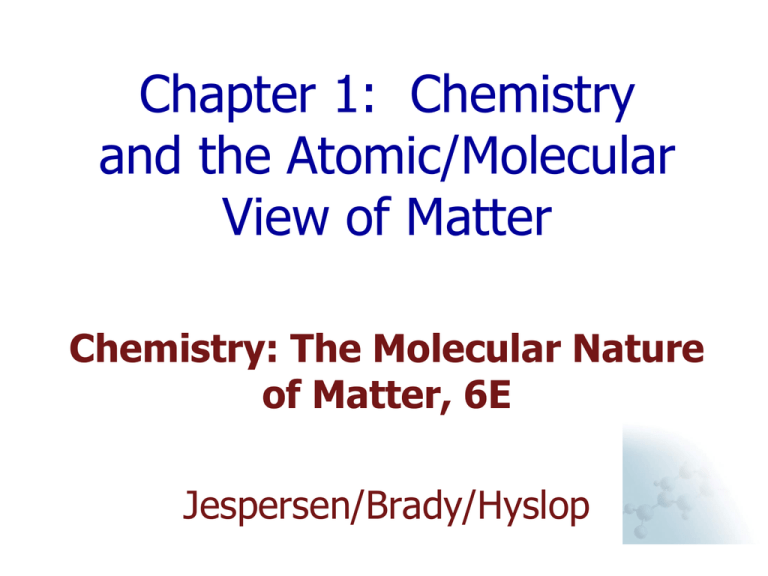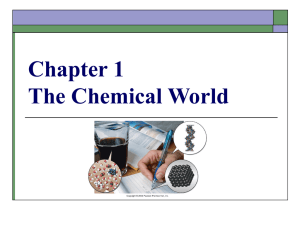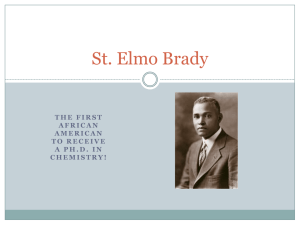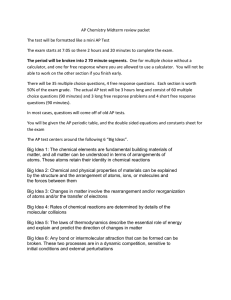ch 1 chem
advertisement

Chapter 1: Chemistry and the Atomic/Molecular View of Matter Chemistry: The Molecular Nature of Matter, 6E Jespersen/Brady/Hyslop 1.1 Chemistry and the Sciences Chemistry: Study of matter. (composition, properties, and transformation of matter) Chemist: Seeks answers to fundamental questions about: What makes up materials that compose our world How composition affects properties of substances How substances change when they interact with each other = Chemical Reactions Jespersen/Brady/Hyslop Chemistry: The Molecular Nature of Matter, 6E 2 Chemistry and the Sciences Chemistry Touches all of the natural sciences. Central of science. Although if you not plan to be a chemist, some knowledge of chemistry will surely be valuable to you. knowledge to: Create new materials not found in nature Understand fundamental biological processes that taking place in living organisms. Jespersen/Brady/Hyslop Chemistry: The Molecular Nature of Matter, 6E 3 Names of Some of the Divisions of the American Chemical Society Agricultural & Food Chemistry Biochemical Technology Biological Chemistry Cellulose Paper and Textile Industrial and Engineering Chemistry Nuclear Chemistry and Technology Jespersen/Brady/Hyslop Chemical Health and Safety Computer in chemistry Environmental chemistry Petroleum Chemistry Medicinal chemistry Business Development & Management Chemistry: The Molecular Nature of Matter, 6E 4 1.2 Scientific Method Approach to gathering information & formulating explanations. Scientists perform experiments in laboratories under controlled conditions 1. Make observations/collect data Qualitative Descriptions Quantitative Measurements Jespersen/Brady/Hyslop Chemistry: The Molecular Nature of Matter, 6E 5 Scientific Method 2. Law or Scientific Law Based on results of many experiments Only states what happens Doesn’t explain why they happen 3. Formulate Hypothesis Possible Explanations for Observed Characteristics or Behaviors Perform Experiments Test Hypothesis Jespersen/Brady/Hyslop Chemistry: The Molecular Nature of Matter, 6E 6 Scientific Method 4. Theory Tested explanation of how nature behaves Devise further tests Depending on results, may have to modify theory Can never prove theory is absolutely correct Jespersen/Brady/Hyslop Chemistry: The Molecular Nature of Matter, 6E 7 Scientific Method Ex. Study gases Discover Volume (V) of gas depends on Pressure (P) Temperature (T) Amount (n) Data Recorded observations of relationship between V, P, T & n Law R = constant PV nRT Kinetic Theory of Gases Explains gas behavior (Ch 11) Jespersen/Brady/Hyslop Chemistry: The Molecular Nature of Matter, 6E 8 Atomic Theory Most significant theoretical model of nature Atoms Tiny submicroscopic particles Make up all chemical substances Make up everything in Macroscopic world Smallest particle that has all properties of given element Composed of: Electrons Neutrons Protons Jespersen/Brady/Hyslop Chemistry: The Molecular Nature of Matter, 6E 9 1.3 Matter & Its Classifications Matter Anything that has mass & occupies space Jespersen/Brady/Hyslop Chemistry: The Molecular Nature of Matter, 6E 10 Pure Substance vs. Mixture Pure substances Made up of one type of substance. Elements and compounds Composition always same regardless of source Mixture Made up of two or more substances Can have variable compositions Ex. CO2 in water—varying amounts of “fizz” in soda 2 broad categories of mixtures: Heterogeneous Homogeneous Jespersen/Brady/Hyslop Chemistry: The Molecular Nature of Matter, 6E 11 Elements Substances that can’t be decomposed into simpler materials by chemical reactions Substances composed of only 1 type of atom Simplest forms of matter that we can work with directly More complex substances composed of elements in various combinations diamond = carbon gold Jespersen/Brady/Hyslop sulfur Chemistry: The Molecular Nature of Matter, 6E 12 Chemical Symbols for Elements Chemical Symbol One or two letter symbol for each element name First letter capitalized, second letter lower case Ex. C = carbon Ca = calcium Br = bromine Cl = chlorine S = sulfur Ar = argon H = hydrogen O = oxygen Most based on English name Some based on Latin or German names Jespersen/Brady/Hyslop Chemistry: The Molecular Nature of Matter, 6E 13 Chemical Symbols English Name Chemical Symbol Sodium Na Potassium K Iron Fe Latin Name Natrium Kalium Ferrum Copper Silver Gold Mercury Antimony Cu Ag Au Hg Sb Cuprum Argentum Aurum Hydrargyrum Stibium Tin Sn Stannium Lead Tungsten Pb W Plumbum Wolfram (German) Jespersen/Brady/Hyslop Chemistry: The Molecular Nature of Matter, 6E 14 Compounds Formed from 2 or more atoms of different elements Always combined in same fixed ratios by mass Can be broken down into elements by some chemical changes Ex. Water decomposed to elemental hydrogen & oxygen Mass of oxygen = 8 × mass of hydrogen Jespersen/Brady/Hyslop Chemistry: The Molecular Nature of Matter, 6E 15 Homogeneous Mixtures Same properties throughout sample Solution Thoroughly stirred homogeneous mixture Ex. Liquid solution Sugar in water Gas solution Air Contains nitrogen, oxygen, carbon dioxide & other gases Solid solution US 5¢ coin – Metal Alloy Contains copper & nickel metals Jespersen/Brady/Hyslop Chemistry: The Molecular Nature of Matter, 6E 16 Heterogeneous Mixtures 2 or more regions of different properties Solution with multiple phases Separate layers Ex. Salad dressing Oil & vinegar Ice & water Same composition 2 different physical states Jespersen/Brady/Hyslop Chemistry: The Molecular Nature of Matter, 6E 17 Learning Check: Classification Hot Ice White Table Cocoa (H2O) Flour Salt (NaCl) Pure substance X X X X X Element Compound Molecule Heterogeneous Mixture Homogeneous Mixture Jespersen/Brady/Hyslop X X Chemistry: The Molecular Nature of Matter, 6E 18 Physical Change No new substances formed Substance may change state or the proportions Ex. Ice melting Sugar or salt dissolving Stirring iron filings & sulfur together Jespersen/Brady/Hyslop Chemistry: The Molecular Nature of Matter, 6E 19 Chemical Change or Chemical Reaction Formation of new substance or compound Involves changing chemical makeup of substances New substance has different physical properties Can’t be separated by physical means Ex. Fool’s gold Compound containing sulfur & iron No longer has same physical properties of free elements Can’t be separated using magnet Jespersen/Brady/Hyslop Chemistry: The Molecular Nature of Matter, 6E 20 Learning Check: For each of the following, determine if it represents a Chemical or Physical Change: Chemical Physical Magnesium burns when heated Magnesium metal tarnishes in air Magnesium metal melts at 922 K Grape Kool-aid lightens when water is added Jespersen/Brady/Hyslop X X Chemistry: The Molecular Nature of Matter, 6E X X 21 1.4 Dalton’s Atomic Theory John Dalton Developed underlying theory to explain Law of Conservation of Mass Law of Definite Proportions Reasoned that if atoms exist, they have certain properties Jespersen/Brady/Hyslop Chemistry: The Molecular Nature of Matter, 6E 22 Dalton’s Atomic Theory 1. Matter consists of tiny particles called atoms. 2. Atoms are indestructible. In chemical reactions, atoms rearrange but do not break apart. 3. In any sample of a pure element, all atoms are identical in mass & other properties. 4. Atoms of different elements differ in mass & other properties. 5. In given compound, constituent atoms are always present in same fixed numerical ratio. Jespersen/Brady/Hyslop Chemistry: The Molecular Nature of Matter, 6E 23 Proof Of Atoms Early 1980’s, use Scanning Tunneling Microscope (STM) Surface can be scanned for topographical information Image for all matter shows spherical STM of palladium regions of matter Atoms Jespersen/Brady/Hyslop Chemistry: The Molecular Nature of Matter, 6E 24 Molecules Atoms combine to form more complex substances Discrete particles Each composed of 2 or more atoms Ex. Molecular oxygen, O2 Carbon dioxide, CO2 Ammonia, NH3 Sucrose, C12H22O11 Jespersen/Brady/Hyslop Chemistry: The Molecular Nature of Matter, 6E 25 Chemical Formulas Specify composition of substance Chemical symbols Represent atoms of elements present Subscripts Given after chemical symbol Represents relative numbers of each type of atom Ex. Fe2O3 : iron & oxygen in 2:3 ratio Jespersen/Brady/Hyslop Chemistry: The Molecular Nature of Matter, 6E 26 Chemical Formulas Free Elements Element not combined with another in compounds Just use chemical symbol to represent Ex. Iron Sodium Fe Na Neon Ne Aluminum Al Diatomic Molecule Molecules composed of 2 atoms each Many elements found in nature Ex. Oxygen Hydrogen O2 H2 Jespersen/Brady/Hyslop Nitrogen Chlorine N2 Cl2 Chemistry: The Molecular Nature of Matter, 6E 27 Depicting Molecules Want to show: Order in which atoms are attached to each other 3-dimensional shape of molecule Three ways of visualizing molecules: 1. Structural formula 2. Ball-and-Stick model 3. Space filling model Jespersen/Brady/Hyslop Chemistry: The Molecular Nature of Matter, 6E 28 Structural Formulas Use to show how atoms are attached Atoms represented by chemical symbols Chemical bonds attaching atoms indicated by lines H H O H H2O water H C H H CH4 methane Jespersen/Brady/Hyslop Chemistry: The Molecular Nature of Matter, 6E 29 Hydrates Crystals that contain water molecules Ex. plaster: CaSO4∙2H2O calcium sulfate dihydrate Water is not tightly held Dehydration Removal of water by heating Remaining solid is anhydrous (without water) Blue = CuSO4 •5H2O Jespersen/Brady/Hyslop White = CuSO4 Chemistry: The Molecular Nature of Matter, 6E 30 Counting Atoms 1. Subscript following chemical symbol indicates how many of that element are part of the formula No subscript implies a subscript of 1. 2. Quantity in parentheses is repeated a number of times equal to the subscript that follows. 3. Raised dot in formula indicates that the substance is a hydrate Number preceding H2O specifies how many water molecules are present. Jespersen/Brady/Hyslop Chemistry: The Molecular Nature of Matter, 6E 31 Counting Atoms Ex. 1 (CH3)3COH Subscript 3 means 3 CH3 groups So from(CH3)3, we get 3 × 1C = 3C 3 × 3H = 9H #C = 3C + 1C = 4 C #H = 9H + 1H = 10 H #O = 1 O Total # of atoms = 15 atoms Jespersen/Brady/Hyslop Chemistry: The Molecular Nature of Matter, 6E 32 Counting Atoms Ex. 2 CoCl2 · 6H2O The dot 6H2O means you multiple both H2 & O by 6 So there are: #H 6 × 2 = 12 H #O 6×1= 6O #Co 1 × 1 = 1 Co #Cl 2 × 1 = 2 Cl Total # of atoms = 21 atoms Jespersen/Brady/Hyslop Chemistry: The Molecular Nature of Matter, 6E 33 Your Turn! Count the number of each type of atom in the chemical formula given below a. b. c. d. e. Na2CO3 (NH4)2SO4 Mg3(PO4)2 CuSO4∙5H2O (C2H5)2N2H2 a. b. c. d. e. Jespersen/Brady/Hyslop ___Na, ___ 2 1 C, ___ 3 O ___N, ___H, ___S, ___O 2 8 1 4 ___Mg, ___P, ___O 3 2 8 ___Cu, ___S, ___O, ___H 9 10 1 1 ___C, ___H, ___N 12 4 2 Chemistry: The Molecular Nature of Matter, 6E 34 Dalton’s Atomic Theory Successes: Explains Law of Conservation of Mass Chemical reactions correspond to rearranging atoms. Explains Law of Definite Proportions Given compound always has atoms of same elements in same ratios. Predicted Law of Multiple Proportions Not yet discovered Some elements combine to give 2 or more compounds Ex. SO2 & SO3 Jespersen/Brady/Hyslop Chemistry: The Molecular Nature of Matter, 6E 35 Law Of Multiple Proportions When 2 elements form more than one compound, different masses of one element that combine with same mass of other element are always in ratio of small whole numbers. Atoms react as complete (whole) particles. Chemical formulas Indicate whole numbers of atoms Not fractions Jespersen/Brady/Hyslop Chemistry: The Molecular Nature of Matter, 6E 36 Using Law Of Multiple Proportions Mass S Mass O sulfur dioxide 32.06 g 32.00 g sulfur trioxide 32.06 g 48.00 g Use this data to prove law of multiple proportions Jespersen/Brady/Hyslop Chemistry: The Molecular Nature of Matter, 6E 37 1.6 Chemical Reactions When 1 or more substances react to form 1 or more new substances Ex. Reaction of methane, CH4, with oxygen, O2, to form carbon dioxide, CO2, & water, H2O. Reactants = CH4 & O2 Products = CO2 & H2O How to depict? Words too long Pictures too awkward Jespersen/Brady/Hyslop Chemistry: The Molecular Nature of Matter, 6E 38 Chemical Equations Use chemical symbols & formulas to represent reactants & products. Reactants on left hand side Products on right hand side Arrow () means “reacts to yield” Ex. CH4 + 2O2 CO2 + 2H2O Coefficients Numbers in front of formulas Indicate how many of each type of molecule reacted or formed Equation reads “methane & oxygen react to yield carbon dioxide & water” Jespersen/Brady/Hyslop Chemistry: The Molecular Nature of Matter, 6E 39 Conservation of Mass in Reactions Mass can neither be created nor destroyed This means that there are the same number of each type of atom in reactants & in products of reaction If # of atoms same, then mass also same CH4 + 2O2 CO2 + 2H2O 4 H + 4O + C = 4 H + 4O + C Jespersen/Brady/Hyslop Chemistry: The Molecular Nature of Matter, 6E 40 Balanced Chemical Equation Ex. 2C4H10 + 13O2 8CO2 + 10H2O 4 C & 10 H per molecule 2 O per molecule 1C&2O per molecule 2H&1O per molecule Subscripts Define identity of substances Must not change when equation is balanced Jespersen/Brady/Hyslop Chemistry: The Molecular Nature of Matter, 6E 41 Balanced Chemical Equation Ex. 2C4H10 + 13O2 8CO2 + 10H2O 2 molecules of C4H10 13 molecules 8 molecules of O2 of CO2 10 molecules of C4H10 Coefficients Number in front of formulas Indicate number of molecules of each type Adjusted so # of each type of atom is same on both sides of arrow Can change Jespersen/Brady/Hyslop Chemistry: The Molecular Nature of Matter, 6E 42 Balanced Chemical Equations How do you determine if an equation is balanced? Count atoms Same number of each type on both sides of equation? If yes, then balanced If no, then unbalanced Ex. 2C4H10 + 13O2 8CO2 + 10H2O Reactants Products 2×4 = 8 C 8×1 = 8 C 2×10 = 20 H 10×2 = 20 H 13×2 = 26 O (8×2)+(10×1)= 26 O Jespersen/Brady/Hyslop Chemistry: The Molecular Nature of Matter, 6E 43 Learning Check Fe(OH)3 + 2 HNO3 Fe(NO3)3 + 2 H2O Reactants Fe 1 Products 1 O 3 + (2×3) = 9 (3×3) + 2 = 11 H 3+2=5 (2×2) = 4 N 2 3 Not Balanced Only Fe has same number of atoms on either side of arrow. Jespersen/Brady/Hyslop Chemistry: The Molecular Nature of Matter, 6E 44 Your Turn! How many atoms of each element appear on each side of the arrow in the following equation? 4NH3 + 3O2 → 2N2 + 6H2O Reactants Products N (4 × 1) = 4 (2 × 2) = 4 O (3 × 2) = 6 (6 × 1) = 6 H (4 × 3) = 12 (6 × 2) = 12 Jespersen/Brady/Hyslop Chemistry: The Molecular Nature of Matter, 6E 45








